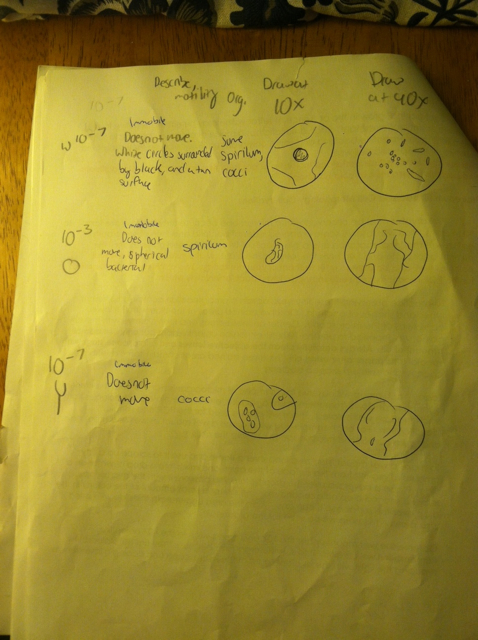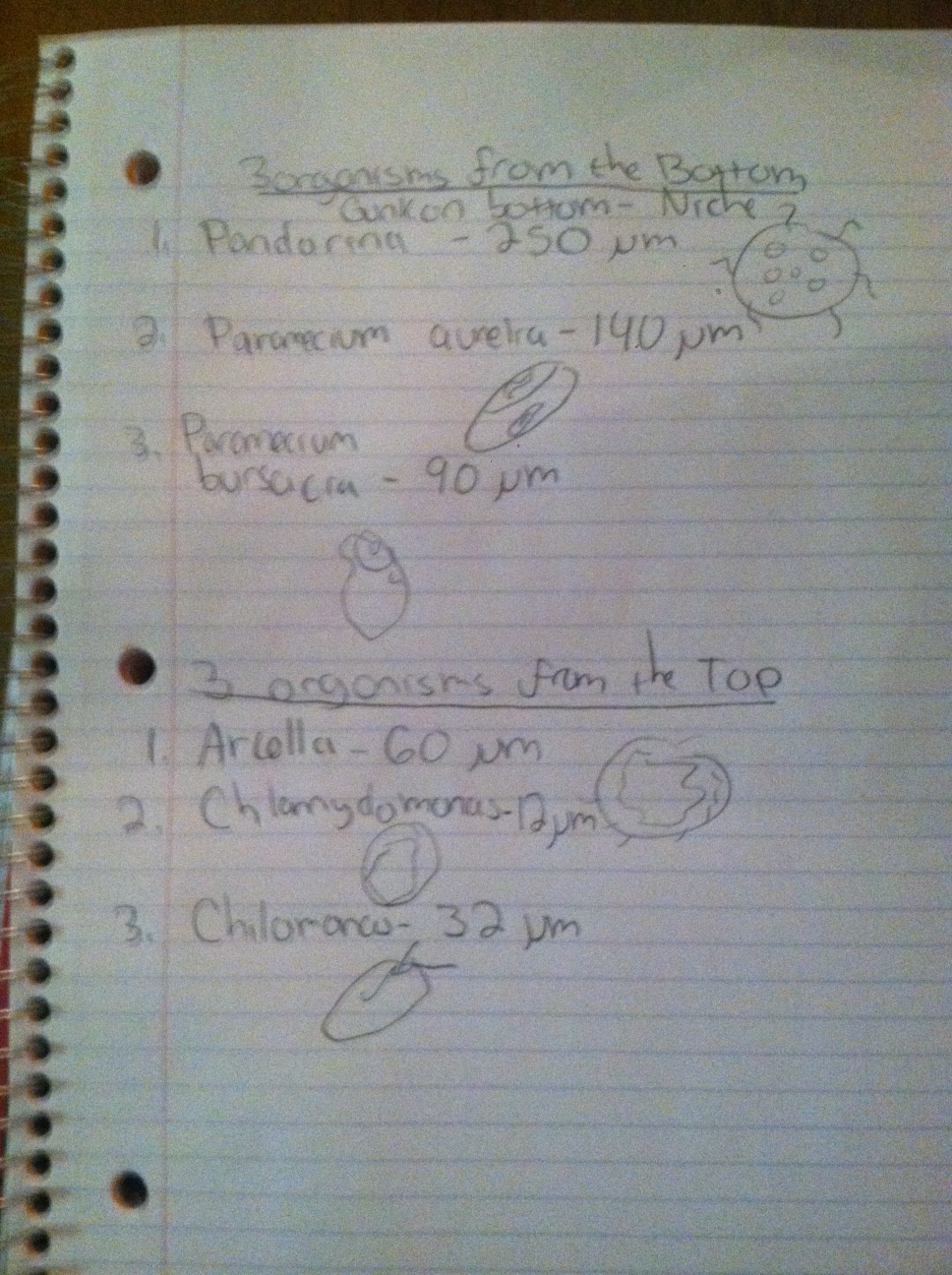User:Jessica Kerpez/Notebook/Biology 210 at AU: Difference between revisions
No edit summary |
No edit summary |
||
| Line 1: | Line 1: | ||
'''February 24, 2013''' | |||
LAB 5: Invertebrates | |||
Acoelomate move by gliding, and lack a coelom. Therefore, they are lacking support. Acoelomates have no body cavity at all. They are not as complex in their muscle movement. Pseudocoelomates move by shifting next to eachother, in a less defined way than the coelomates. They are not as complex in their muscle movement than coelomates, but they appear somewhat more complex than the acoelomates. The coelomates appear to have a more complex movement, and move by a series of muscle contractions that move their bodies. Coelomates have a fluid filled body cavity called the coelom that has a mesoderm lining. Vertebrates are coelomates. | |||
Table of Organisms: | |||
1. Ground Spider LL- 1 mm in length. The ground spider has no wings, no antennae, 2 body segments, and 8 legs. | |||
2. Millipede- 4.5 mm in length. The millipede has no wings, 1 pair of antennae, several body segments, 2 pairs of legs on each side, and a round body. | |||
3. Centipede- 5 mm in length. The centipede has no wings, 1 pair of antennae, several body segments, 1 pair of legs on each side, and a flat body. | |||
*We were not able to find any more organisms. | |||
The size range of the organisms we measured was from 1 mm in length to 5 mm in length, a 4 mm difference. The largest organism we discovered was the centipede, and the smallest organism was the ground spider. The organisms that were most common was the centipede. | |||
Some vertebrates that might inhabit the transect: | |||
Crows (Chordata, Aves, Passeriformes, Corvidae, Corvus, Corvus brachyrhynchos) | |||
Biotic Advantage: Invertebrates for food, such as worms | |||
Abiotic Advantage: Man made feeder | |||
Cardinals (Chordata, Aves, Passeriformes, Passeri, Cardinlidae, Periporphyrus, Cardinalis) | |||
Biotic Advantage: Invertebrates for food, such as worms | |||
Abiotic Advantage: Man made feeder, soil | |||
Squirrels (Chordata, Mammalia, Rodentia, Sciuridae, Sciurus, Sciurus carolinensis) | |||
Biotic Advantage: Nuts, seeds, green plants for food | |||
Abiotic Advantage: Water feeder, soil | |||
Rabbits (Chordata, Mammalia, Lagomorpha, Leporidae, Oryctolagus, Cuniculus) | |||
Biotic Advantage: Grass or plants for food | |||
Abiotic Advantage: Water feeder, soil | |||
Common Frog (Chordata, Amphibia, Anura, Ranidae, Rana, Rana) | |||
Biotic Advantage: Presence of bugs, worms | |||
Abiotic Advantage: soil | |||
Food web: | |||
[[Image:Photo (7).jpg]] | |||
'''J.K''' | |||
'''February 20, 2013''' | |||
LAB 4: Plantae and Fungi | LAB 4: Plantae and Fungi | ||
Revision as of 23:02, 23 February 2014
February 24, 2013
LAB 5: Invertebrates
Acoelomate move by gliding, and lack a coelom. Therefore, they are lacking support. Acoelomates have no body cavity at all. They are not as complex in their muscle movement. Pseudocoelomates move by shifting next to eachother, in a less defined way than the coelomates. They are not as complex in their muscle movement than coelomates, but they appear somewhat more complex than the acoelomates. The coelomates appear to have a more complex movement, and move by a series of muscle contractions that move their bodies. Coelomates have a fluid filled body cavity called the coelom that has a mesoderm lining. Vertebrates are coelomates.
Table of Organisms:
1. Ground Spider LL- 1 mm in length. The ground spider has no wings, no antennae, 2 body segments, and 8 legs.
2. Millipede- 4.5 mm in length. The millipede has no wings, 1 pair of antennae, several body segments, 2 pairs of legs on each side, and a round body.
3. Centipede- 5 mm in length. The centipede has no wings, 1 pair of antennae, several body segments, 1 pair of legs on each side, and a flat body.
- We were not able to find any more organisms.
The size range of the organisms we measured was from 1 mm in length to 5 mm in length, a 4 mm difference. The largest organism we discovered was the centipede, and the smallest organism was the ground spider. The organisms that were most common was the centipede.
Some vertebrates that might inhabit the transect:
Crows (Chordata, Aves, Passeriformes, Corvidae, Corvus, Corvus brachyrhynchos)
Biotic Advantage: Invertebrates for food, such as worms Abiotic Advantage: Man made feeder
Cardinals (Chordata, Aves, Passeriformes, Passeri, Cardinlidae, Periporphyrus, Cardinalis)
Biotic Advantage: Invertebrates for food, such as worms Abiotic Advantage: Man made feeder, soil
Squirrels (Chordata, Mammalia, Rodentia, Sciuridae, Sciurus, Sciurus carolinensis)
Biotic Advantage: Nuts, seeds, green plants for food Abiotic Advantage: Water feeder, soil
Rabbits (Chordata, Mammalia, Lagomorpha, Leporidae, Oryctolagus, Cuniculus)
Biotic Advantage: Grass or plants for food Abiotic Advantage: Water feeder, soil
Common Frog (Chordata, Amphibia, Anura, Ranidae, Rana, Rana)
Biotic Advantage: Presence of bugs, worms Abiotic Advantage: soil
J.K
February 20, 2013
LAB 4: Plantae and Fungi
Fungi sporangi are a cell that contains spores, sporangium can be the site of meiosis or mitosis. They are significant because the sporangium must enclose its spores until they are mature and ready to disperse. Asexual sporangia are commonly made by the Chytridomycota and Zygomycota.
I believe this is a fungus because of the spores that open up, the "ascus" spores.
J.K.
"February 20, 2013"
LAB 3: Microbiology and Identifying Bacteria with DNA
Yes, the Archaea species will have grown onto the agar plates. Since they are extremophiles, they can grow in a variety of unique environments, including areas in the ocean and on the mainland. For instance, plankton reside in a lot of aquatic environments.
The appearance or smell of the Hay Infusion Culture would change week to week because of increased life forms, such as fungi, bacteria, or other substances. For instance, in our Hay Infusion Culture there was an increase in the amount of filament on the top layer of the water and a deeper more potent stench.
Yes, I see differences in the colony types between the plates with and without antibiotics. There was no purple on the plate without tetracycline, and a mix of oranges on the plate with tetracycline. This occurred because purple is not resistant to the antibiotic, but yellow, orange, and white are. This indicates that the plate with tetracycline had bacteria that could not be resistant. The net effect of tetracycline on the total number or the bacteria and fungi was that there was a smaller amount. It is harder for the bacteria to survive in this environment, because the tetracycline makes it difficult for translation to occur. There are 3 species unaffected by tetracycline: orange, yellow, and white.
Tetracycline inhibit enzyme reactions needed for bacterial cells. It works by binding to 30S ribosome of bacteria, and then stops the attachment of the aminoacyl tRNA to the RNA-ribosome complex. The types of bacteria that are sensitive to this antibiotic are E. coli, Haemophilus influenzae, Mycobacterium tuberculosis, and Pseudomonas aeruginosa.
1: Immobile, some spirilum/cocci 2: Immobile, spirilum 3: Immobile, cocci
J.K.
February 9th, 2014
LAB 2: Identifying Algae and Protists
There was a clear transformation in our Hay Infusion Culture. The smell of the culture was musky and foul. There was a layer of film that had developed at the top of the jar. There was a thick layer of sludge that was resting at the bottom of the jar, and small spots of green mold.
Organisms near vs away from the plants will different because the species in the area are exposed to two different environments. Species that live far away from the plant may eat the mold that is resting on the bottom of the jar, while species near the plant could feed upon the plant matter.
We got our samples from the top film layer and from the sludge resting at the bottom:
3 Organisms from Bottom Niche- Gunk on Bottom 1. Pandorina- 250 micrometers, green algae, pandorina genus, mobile using flagella. 2. Paramecium Aurelia-140 micrometers, paramecium genus, mobile using cilia. 3. Paramecium Busaria- 90 micrometers, protozoan, paramecium genus, mobile-mobile.
3 Organisms from Top Niche-top film layer of water 1. Arcella- 60 micrometers, Arcella genus, mobile 2. Chlamydomonas- 12 micrometers, green algae, Chlamydomonas genus, mobile with flagella 3. Chilomonas - 32 micrometers, chryptophyte, protozoa, chilomonas genus, mobile with flagella
- these organisms do not photosynthesize
Chosen species: Paramecium Aurelia
A Paramecium is a heterotroph, and it gets its food from nutrients within the hay infusion culture (like algae).Paramecium is a genus of unicellular ciliate protozoa. Paramecium move using their cilia and spiral throughout the water. They use a large amount of energy to propel through water. This paramecium reproduces asexually through a process called binary fission.
If the Hay Infusion Culture was observed for another two months, I would expect to see an increase in the amount of mold/algae, and an increase in the amount of organisms living in it because of an increase in bacteria. The color of the culture would darken as more matter built up, and the smell would become increasingly potent.
There is the selective pressure of the search for food and nutrients for the organisms living in the Hay Infusion culture. They are competing for these resources available, as well as mating with various organisms. For instance, if there is a limited amount of plant matter only the fittest organisms can survive.
J.K
1.31.14
LAB 1
Describe the general characteristics of the transect: location, topography, etc. : The transect was located in a grassy area in the middle of two of three large trees near the Washington Seminary. On either side of the grassy area covered in dirt, leaves, and sticks stood two tall trees. The ground was completely covered in leaves because they had fallen from the large trees. The ground and soil was slightly damp from rainfall. In the middle of these two trees was a picnic table and a small, round tennis ball. We also witnessed a small yellow-crested bird perch upon one of the tall trees.
List the abiotic and biotic components:
Abiotic: Tennis ball, picnic table, soil
Biotic: Trees, leaves, bird
Table 1 Evolutionary Specialization of Members of the Volvocine Line
Characteristic Chlamydomonas Gonium Volvox
Number of cells 2 3 1
Colony size 6 5 1
special function motile still still
reproduction specialization isogamy oogamy oogamy
J.K.






